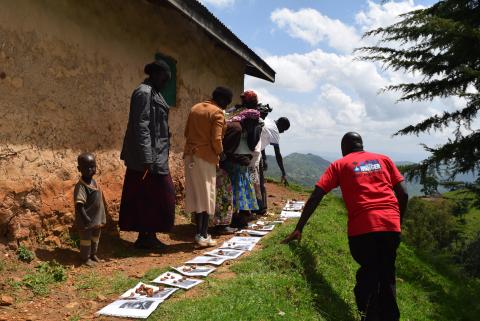Nutrition sensitive multi-sectoral planning: experiences on Link Nutrition Causal Analysis Kenya
By Kevin Mutegi and Jacob Korir
Kevin Mutegi is currently working with Action Against Hunger (ACF-USA) Kenya mission as Food Security and Nutrition Surveillance Programme Manager. He has six years working experience in nutrition, food security and public health programming in Kenya. He provides technical support on research, monitoring and evaluation at national and county levels. He has previously worked for Kenya Red Cross, Africa Medical and Research Foundation, local universities and colleges in various capacities.
Jacob Korir is current Head of the Nutrition Department in the ACF-USA Kenya Mission and has over five years experience in nutrition and health programming. He previously worked for Provide International, World Vision Somalia, Kenya Medical Research Institute and Christian Child Care International in various health and nutrition capacities.
This study was undertaken with financial assistance of the Office of U.S. Foreign Disaster Assistance (OFDA, USAID). It was made possible by the generous support, time and energy of the communities; and county and national-level stakeholders who participated at various stages of Link NCA in West Pokot County. We also appreciate technical support from ACF Kenya staff, the Link NCA project team and ACF technical advisors (see www.linknca.org for more information on the Link NCA project).
Location: West Pokot County, Kenya
What we know: Chronic malnutrition (stunting) is a persistent problem in the arid and semi-arid lands of Kenya, despite a number of initiatives to reduce it.
What this article adds: As part of the Alleviating Chronic Malnutrition Initiative, an ACF-led Link Nutrition Causal Analysis (NCA) study was a key step in developing a risk-factor based, detailed, multi-sectoral response plan to collectively addressing stunting in West Pokot County. Identified stunting risk factors included high prevalence/recurrent childhood illnesses, inadequate dietary diversity, high maternal workload, low income, inadequate access to water and poor hygiene practices. The stunting prevalence of children under five was not influenced by seasonality. A multi-stakeholder workshop, themed around health and nutrition, food security and water, sanitation and hygiene (WASH) identified feasible interventions to deliver a community-based action plan. Engagement of technical and political leadership and influence on budget allocations to nutrition-sensitive and specific programming was necessary; follow up on commitments and implementation is critical.
Introduction
West Pokot County lies in the arid and semi-arid lands (ASAL) of Kenya with a population of 512,690 persons (2009 census). The County has three major livelihood zones: pastoral, agro-pastoral and mixed farming. It is characterised by high rates of both acute and chronic malnutrition. According to the 2014 Kenya Demographic Health Survey (KDHS), the chronic malnutrition (stunting) prevalence is 45.9%, above the World Health Organization (WHO) ‘emergency’ cut-off (40%). Despite a number of initiatives by the Government and other stakeholders, chronic nutrition vulnerability is still pervasive and persistent in the County. This warrants a focus on long-term and holistic approaches that address the causal factors of undernutrition by bringing an array of key stakeholders and expertise under one roof, with the County Government taking the lead role.
Alleviating Chronic Malnutrition Initiative
The need to urgently address chronic undernutrition was driven by the Alleviating Chronic Malnutrition Initiative, which brings together seven national and County Government ministries (health and nutrition, agriculture and livestock, water and sanitation, finance and planning, education, markets, and trade), three UN agencies (UNICEF, FAO and WFP) and two international, non-governmental organisations (INGOs) (ACF and Helen Keller International (HKI)). The Chronic Malnutrition Initiative came up with key steps to achieve its vision, outlined below:
- Preliminary engagement of like-minded stakeholders.
- Engagement of political leadership at county level.
- Enhancing buy-in at multi-sectorial County Steering Group (CSG) level.
- Formation of a national think-tank to provide technical support and guide the process.
- Understanding causality through an NCA process.
- Multi-stakeholder engagement and consensus workshop.
- Development of a multi-sectorial response plan to guide action.
Link NCA methodology
The Link NCA study was one of the pertinent activities outlined in the vision of the initiative. The Link NCA method is a structured, participatory and holistic study based on the UNICEF causal framework that aims to build evidence-based consensus around plausible causes of undernutrition within a local context and assign appropriate response plans to counteract effects of undernutrition.
The study took five months between March and July 2015. It involved the following stages: a preparatory phase (rating of hypothesis based on secondary data review), identifying hypothesised risk factors, field work using qualitative and quantitative approaches, multi-sector engagement and consensus-building on the result and development of response plans. Field work exercise took two and a half months for both qualitative and quantitative components. The qualitative inquiry was used to complement existing sources of information and develop an understanding of undernutrition. Four villages were purposively selected at random for qualitative inquiry; a total of 48 focus group discussions and 30 semi-structured interviews were conducted. Four rating exercises on possible risk factors, through engagement with various community groups, took place. The community groups were also engaged in developing action plans based on community-rated risk factors. The quantitative inquiry involved risk factor and SMART surveys based on livelihood zoning and indicators under study.
Figure 1: Community-rating exercise
A sample size of 640 randomly selected households was achieved with 37 villages chosen across the livelihood zones. Multi-stakeholders at national and county levels were engaged in July 2015 through consensus-building on findings, rating exercise of risk factors and development of response plans. Results from the NCA formed the basis of a detailed multi-sectoral response plan towards the vision of collectively addressing stunting in the County. Technical representatives from various sectors used sector-specific findings to develop interventions through the problem, solution/intervention and stakeholder trees analysis approach. Community-rated risk factors and action plans derived during the field work in June 2015 were also prioritised in the process of developing multi-sector response plans. In addition to prioritising key interventions, the response outlined desired change, advocacy objectives and stakeholder responsibilities for the follow-up on implementation of interventions. Advocacy objectives were developed to guide planning and implementation of proposed interventions based on risk factors identified.
Summary findings of the Link NCA
A key component of the qualitative inquiry was the exploration of community perceptions and causal pathways to undernutrition. The findings revealed that the major risk factors linked to stunting include high prevalence and recurrent episodes of childhood illnesses (see Table 1). It was noted, however, that the prevalence of environmental enteropathy in the County is unknown and needs further investigation. Young children consume contaminated soil picked from the ground, while an unhealthy environment coupled with unhygienic practices are among major risk factors linked to undernutrition (stunting), (Campbell, Elia & Lunn, 2003). Prolonged seasonal (rainfall) failure coupled with a myriad of vulnerabilities over time rendered households chronically food insecure. Low sources of income, coupled with low engagement of women in decision-making processes related to resource/assets utilisation at the household level, significantly contributes to poor dietary diversity and intake among children. Other major risk factors identified included high maternal workload, low access to safe water and poor care practices. The Link NCA findings also revealed important risk factors to include low access to health services, poor health-seeking practices, low women empowerment, low education levels among care givers (mothers), low crop and livestock productivity, low birth weight and poor child spacing. It was also noted that poor nutritional status among pregnant and lactating women contributed to low birth weight and stunted growth of babies. The minor risk factors identified included high food prices, insecurity and low micronutrient supplementation. It is important to note that stunting peaks do not follow a regular seasonal trend as is the case in wasting, but the various risk factors for stunting were related to persistent rainfall failure or mild droughts reported over the years.
A major output of the Link NCA survey is the design of a local causal model to explain the main causes and pathways to undernutrition in the target area. By triangulating the results from the preliminary research, the result of the risk factors survey and the findings of the qualitative survey, a local causal model was designed, as illustrated in Figure 2. Major, important, minor and repeated risk factors and their interplay were used in developing a multi-sector response plan.
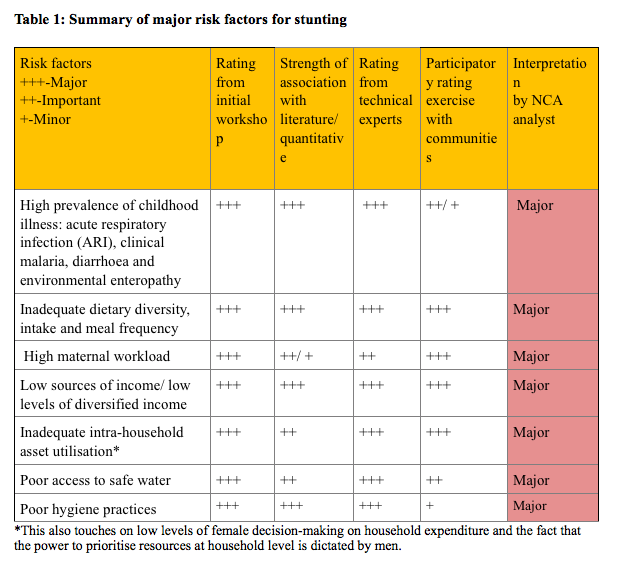
Figure 2: Local causal model of undernutrition in agro-pastoral and mixed farming livelihood zones, West Pokot County
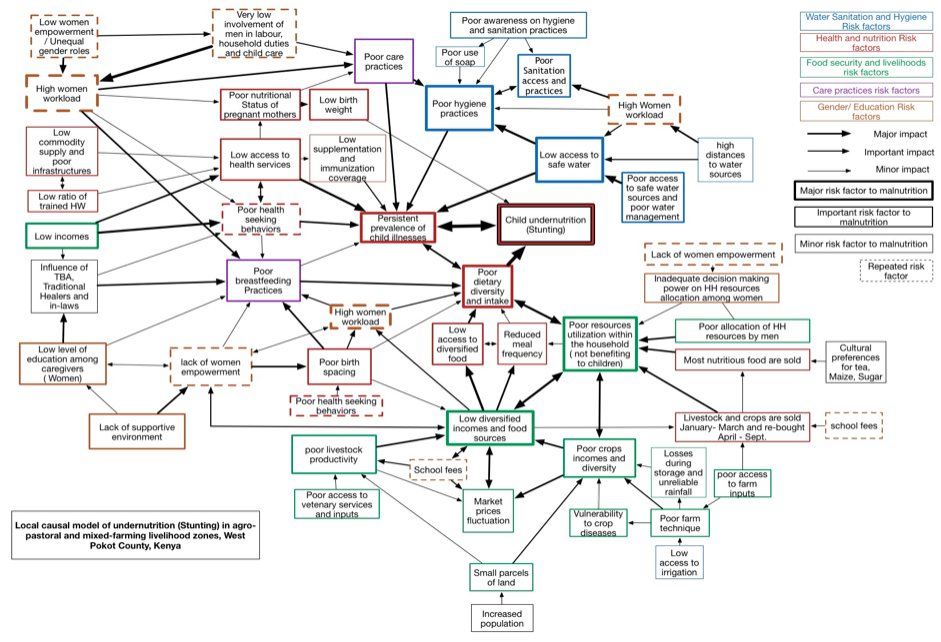
Response planning
Brief overview of response analysis
Response analysis is a step towards linking a situation analysis phase with a programme design or programming phase (Levine & Chastre, 2011; Maxwell & Stobaugh, 2012) as highlighted in Figure 3. Situation analysis itself is understood as a discrete phase that follows assessment but precedes response analysis, or more commonly is included as an initial or precursor to response analysis. In the latter, the results of situation analysis are viewed through the lens of response, analytical ‘gaps’ are plugged where they exist (severity, magnitude, target groups, vulnerability analysis, gap and risk analysis, etc.), and forecasting and scenario-building is undertaken before potential response options are identified (FAO 2011). Across the board, response analysis is essentially focused on identification, examination and selection of a set of appropriate and feasible response options, based on certain predefined technical and operational criteria.

Monitoring and evaluation
Link NCA multi-sectoral response plan
The multi-variate risk factors linked to undernutrition (stunting) in this population required a joint multi-sectoral approach in designing response plans to address the basic and underlying causes of chronic vulnerability. Multi-stakeholders at county and national level were involved in developing response plans, based on identified risk factors (Figures 2 and 3), during a three-day multi-stakeholder workshop. The process of developing a situational and response analysis was based on stakeholder understanding of the risk factors, their interplay on stunting and development of a community action plan. Other areas of focus to ensure all stakeholders present were ‘on the same page’ included a brief on ‘What is malnutrition?’, types of malnutrition, vulnerable groups and the Link NCA process. The community action plan was developed from qualitative inquiry and community-rating exercise of risk factors. The NCA analyst explored community viewpoints on amenable solutions and strategies to mitigate the risk factors identified (see Table 2).
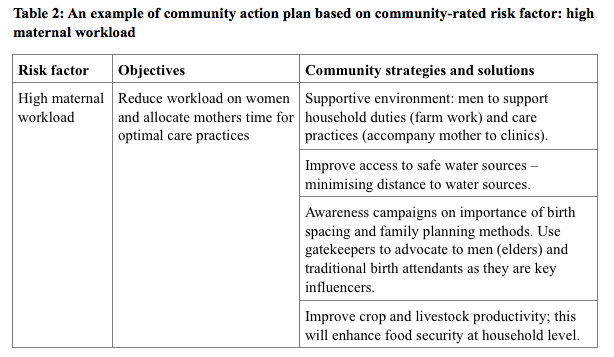
The team discussed the differences between nutrition-specific and nutrition-sensitive interventions in detail. The process was led by representatives from government line ministries with facilitation from other participants, including Action Against Hunger (and its Nutrition Security policy principles), nutrition causal analyst/consultant, Food and Agricultural Organisation (FAO), National Drought Management Authority (NDMA), UN World Food Programme (WFP) and the Scaling Up Nutrition Civil Society Alliance (SUN CSA) represented by the Kenya Red Cross Society (KRCS) and UNICEF. The County political and technical leadership were also present during the multi-stakeholder engagement workshop.
In order to ensure multi-stakeholder engagement, three thematic areas were developed during the final workshop: health and nutrition; food security; and WASH. Cross-cutting themes such as advocacy, gender, care practices, environment, markets and trade were incorporated into the three thematic areas. One technical expert representative for each thematic area was appointed to lead during plenary discussions and on technical consensus-building in developing the problem analysis tree. The stakeholders within the thematic groups were involved in developing amenable solutions through converting problems into solutions using a solution analysis pathway matrix (Figure 4). They were also involved in formulating feasible interventions in relation to proposed community action plans (see example in Figure 5). The engagement of the SUN Civil Society Alliance (CSA) Movement was key in packaging the NCA findings and multi-sectoral response plans into clear advocacy messages used to inform county leadership, donors and implementing partners on the need to allocate resources based on identified priorities (see Table 3 for an example). The leaders present at the workshop including chief executive officers for health committed to allocating more resources for scaling up programmes for 2015-2016.
Figure 4: Multi-stakeholders forum during the design phase of response plan
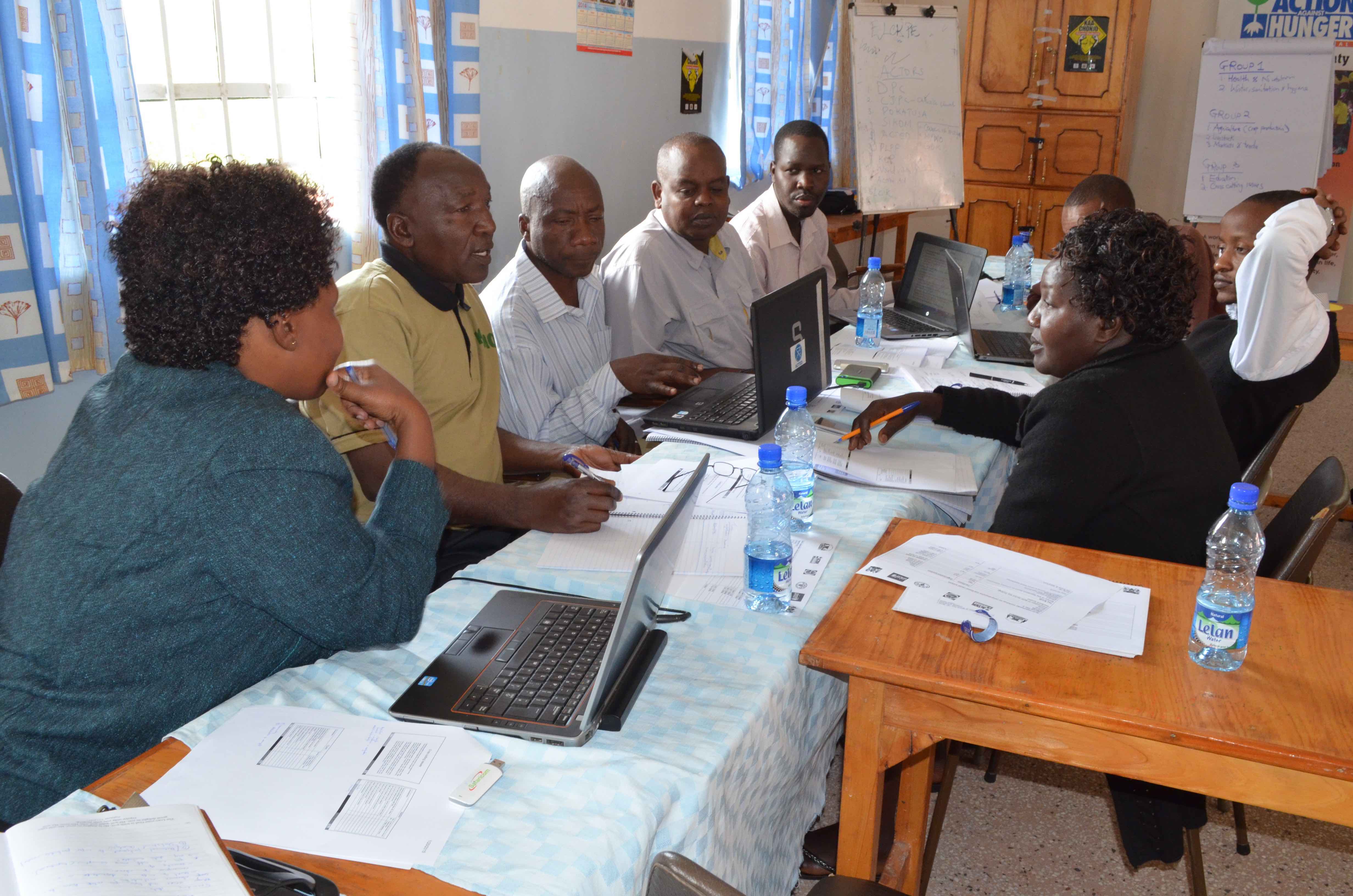
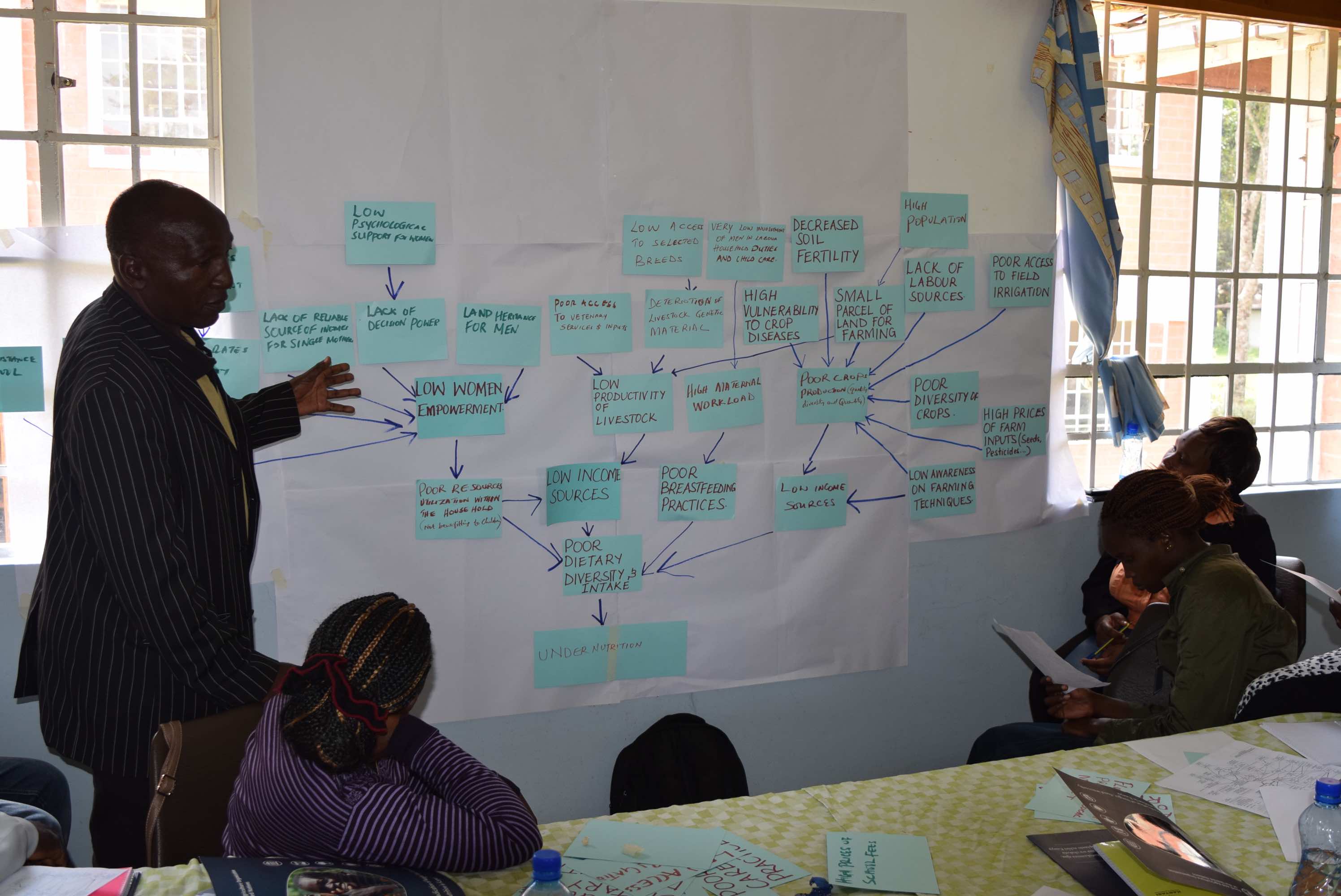

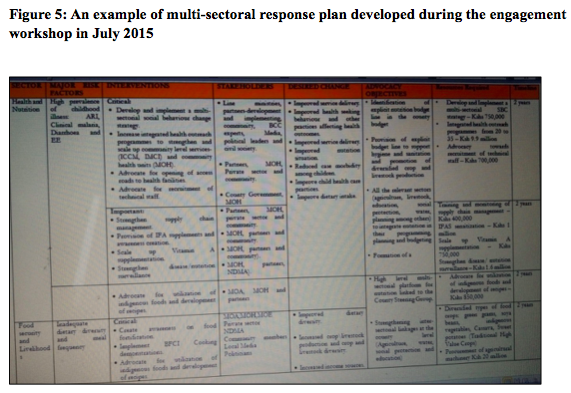
Challenges, lessons learned and way forward
During the implementation of the NCA and response analysis process, a number of challenges were faced and ways forward identified, as highlighted in Table 4.
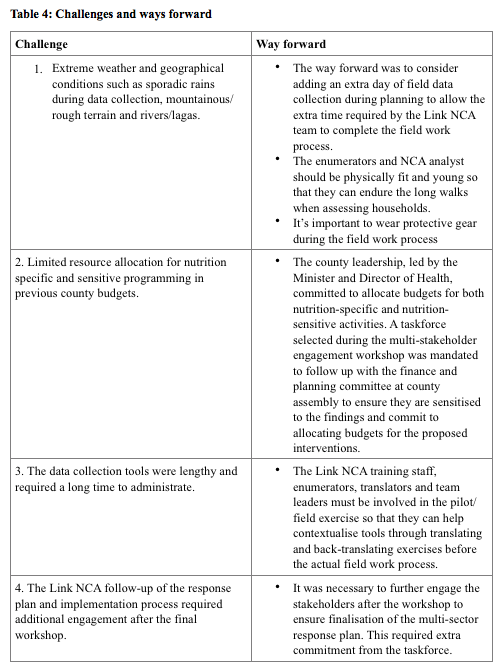
There is a need to engage all stakeholders in all stages of NCA to ensure they understand and buy into the process. The pace of implementation of recommendations is dictated by the clarity of response plans and engagement of technical and political leadership from the outset. The NCA approach encourages multi-sector participation; the mixed-method approach used benefits exploration and understanding of the causal links and interplay of various risk factors linked to undernutrition (in this instance, stunting).
Community inputs and feedback are required for rating of risk factors and development and follow-up on action plans. The county government representatives from various ministries committed to increase resources within the various sectors in the next county budgetary allocations, costing and planning. This is at least in part due to their full engagement from the start of the analysis and response-planning process. Continuous follow-up of proposed interventions and their implementation is key to ensure actualisation of the proposed response plan.
The causal pathway of risk factors linked to stunting indicated that stunting prevalence among under fives was not influenced by seasonality factors.
This was the first time the Link NCA was conducted based on livelihood zoning. Risk factors analysis and vulnerability context were similar for agro-pastoral and mixed-farming livelihood zones but distinct for pastoral livelihood zones; previously used assessment methods have not demonstrated this distinction. For this reason, a separate Link NCA study has been proposed for pastoral livelihood zones.
For more information, email Kevin Mutegi or Jacob Kipruto
References
Campbell, D.I., Elia, M., & Lunn, P.G. (2003). Growth faltering in rural Gambian infants is associated with impaired small intestinal barrier function, leading to endotoxemia and systemic inflammation; Journal of Nutrition, American Society of Nutrition.
FAO (2011). Developing a response analysis framework for food security emergencies. Discussion paper. www.fao.org/fileadmin/user_upload/emergencies/docs/Response_Analysis_Framework_Discussion_Papers.pdf
Maxwell, D., and Stobaugh, H., (2012). Response Analysis: What Drives Programme Choice? Feinstein International Centre.
Levine, S., and Chastre, C., (2011). Nutrition and food security response analysis in emergency contexts. HPG commissioned paper, Dec 2011.


